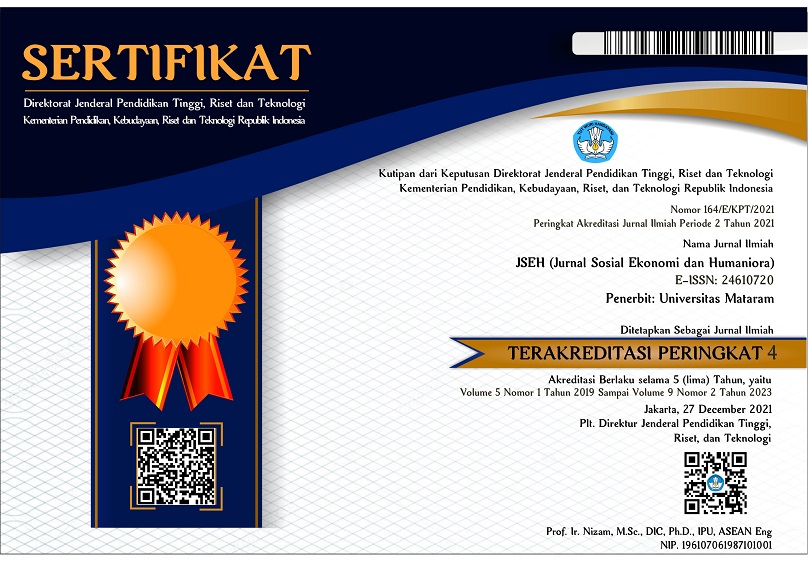Akses Usaha Kecil dan Mikro (UKM) terhadap Kredit Usaha Rakyat (KUR) dan Dampaknya terhadap Perkembangan Usaha: Kasus UKM di Kota Mataram
Keywords:
Moringa Ore Charcoal, Iron (Fe) Level, Dug Well WaterAbstract
Small and Micro Enterprises (SMEs) have a significant role for Indonesia's gross domestic product and employment. However, most SMEs face capital constraints and limited access to formal financial institutions. Kredit Usaha
Rakyat (KUR) Fund is one of the credit programs established by the Indonesian Government to overcome capital constraints on SMEs. The study aims to analyze the ability of SMEs to access the KUR loans and the loan’s impact on business development. Primary data was obtained from interviews of 40 respondents who are SMEs in Mataram City. Ability to access the KUR loans was analyzed by logistic regression method while Ordinary Least Square (OLS) was employed to analyze the impact of KUR loans on business development. The result of logit regression shows that the variable of savings and sales influence the ability of SME to access the KUR loan. The KUR funds granted are able to increase SME's sales value by 82.03 percent from 3.47 billion rupiah to 6.31 billion rupiah per year. Based on the OLS analysis, the ability of SMEs to access capital derived from KUR funds has a positive and significant impact on the value of SME business development.
References
www.komite-kur.com www.smecda.com
BPS, 2014
BPS NTB, 2014
Kementrian Negara KUKM, 2003
Fitria, Nurul dan Raina Linda Sari, (2012).
Analisis Kebijakan Pemberi Kredit Dan Pengaruh Non Performing Loan Terhadap Loan To Deposit Ratio Pada PT. Bank Rakyat Indonesia (Persero) Tbk Cabang Rantau, Aceh Tamiang (Periode 2007-2011). Jurnal Ekonomi dan Keuangan, Vol.1, (No.1).
Hubeis, Musa, (2009). Prospek Usaha Kecil dalam Wadah Inkubator Bisnis. Bogor : Ghalia Indonesia
James, K. dan Akrasanee, N. (1988). Small
and Medium Business Improvement in The Asean Region. Institute of Southeast Asian Studies.
Pudjo Muljono, Teguh (2001). Manajemen Perkreditan Bagi Bank Komersial, Cetakan Ke-
, BPFE Yogyakarta, Yogyakarta.
Rivai, Veithzal, et al., (2013). Commercial Bank Management. Jakarta: Raja Grafindo Persada.
Robinson, M. S., (2001). Sustainable
Microfinance at The Bank Rakyat
Indonesia : The Economic and Social
Profit. Workshop on Instutional Commercial Microfinance for Working Poor.
Surjandari, D A. (2004). Evaluasi terhadap Lembaga Pembiayaan Mikro Yang Beroperasi Dengan Pendekatan Institusi (Studi Pada BRI Jawa Timur).
Suyatno, T, (2005). Kelembagaan Perbankan. Edisi Ketiga. PT. Gramedia Pustaka Utama. Jakarta.
Venkatraman dan Ramanujam, V. (1986).
Measurement of Business Performance in Strategy Research: a Comparison of Approaches. Academy of Management Review, Vol 11, pp.801-814
Walean, Sam A et al. (1990). Bank & Wiraswasta. Edisi ketiga. Jakarta: Sam A Walean.Wikisource. 2013. http://id.wikisource.org/wiki/Undang Undang_Republik_Indonesia_Nomo r_10_Tahun_1998
Widodo, Tri, et al. (2003). Dampak Pola Pembiayaan Usaha Skala Mikro Terhadap Kinerja Bank dan Nasabah (ULM PT Bank BNI Wilayah Jabotabek, Jawa Barat dan DI Yogyakarta), Kerjasama Pusat Studi Ekonomi & Kebijakan Publik Universitas Gajah Mada dan Tim Penelitian & Pengembangan Biro Kredit Bank Indonesia
Downloads
Published
How to Cite
Issue
Section
License

This work is licensed under a Creative Commons Attribution-NonCommercial 4.0 International License.







